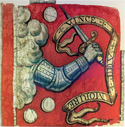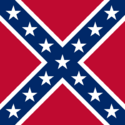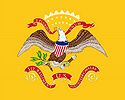American Historical Flags
 From Conservapedia
From Conservapedia | Flags | Detail |
|---|---|
 |
The flag of Christopher Columbus in 1492, bearing the initials of his patrons Ferdinand and Isabela, king and queen of Spain. |
 |
The Cross of Burgundy, flown by Spanish colonists in Florida until the territory's purchase by the United States in the early 1800s. The slightly-modified cross is preserved in the current flags of Alabama and Florida. |
 |
The Union Flag, so named when James VI of Scotland was placed on the throne of England upon the death of Elizabeth I in 1603, which united both kingdoms; it was the flag flown over colonial America prior to the Revolution. |
 |
The Bedford Flag is the oldest known flag of the early American (then British) colonists. The flag was used by the Bedford Minutemen in Massachusetts and during the Battle of Lexington and Concord. The inscription reads VINCE AUT MORIRE which translates to Conquer Or Die. |
.svg.png) |
The Flag of New England is an unofficial flag, closely associated with the New England region. The flag contains an eastern white pine (Pinus Strobus) in the canton, another symbol of the region. It was first seen in 1634 in Salem, Massachusetts, and has many variations. One variation is believed to have flown at the Battle of Bunker Hill, having a blue background with the cross and the tree.[1] |
 |
The flag of Washington's Cruisers, commonly known as the Pine Tree Flag - is the flag of the fleet of ships that comprised the Massachusetts Navy. The Massachusetts Navy was the precursor to the United States Navy. |
 |
This flag was flown by the Sons of Liberty during the Boston Tea Party, earning the sobriquet Rebellious Stripes; it may also have been "the striped jack" referred to in the letters of Commodore Esek Hopkins as one of the first flags of the Continental Navy during the American Revolution |
 |
The 1st Virginia Regiment consisted of about three hundred militiamen under the command of Colonel Patrick Henry; one hundred of these men were from the town of Culpeper, and as all of them marched to Williamsburg in October–November 1775, the Culpeper men flew this flag, based on the symbolism that the rattlesnake represented for the American colonies, with Henry's patriotic words added as well. |
 |
The second jack used by Commodore Hopkins placed a rattlesnake over the words "DON'T TREAD ON ME"; engravings of Hopkins during this period show he did fly such a flag. The First Navy Jack is still in use today, flown on the bows of all United States naval warships. |
 |
By 1775, at the birth of the U.S. Navy and the U.S. Marine Corps, some of the Marines that enlisted during the first month in Philadelphia may have also been the first American citizens to combine the rattlesnake symbol, seen on the Gadsden Flag, with a defiant "Don't Tread on Me" slogan. The Gadsden Flag, chosen by Commodore Hopkins as his personal standard, was designed by Colonel Christopher Gadsden of South Carolina, and presented to the Continental Congress in 1776. Hopkins flew this flag during the first amphibious invasion conducted by the American Navy in the Bahamas. Outside of the military, all three rattlesnake flags have found a use in the Tea Party Movement as a visual banner and symbol against an overbearing - and increasingly hostile - Federal government. |
 |
Considered the first flag of the United States, the Grand Union Flag was in use from late 1775 until mid 1777. |
 |
Allegedly created at the request of George Washington in June, 1776, the Betsy Ross flag has much legend instead of fact surrounding it; Ross is popularly credited with this creation of the first Stars and Stripes. |
 |
Benjamin Franklin had this flag hurriedly-created for Captain John Paul Jones while in the Netherlands; apparently, Jones was going to be arrested and charged with piracy for his depredations against the British on the high seas, and his actual colors were lost when his ship Bonhomme Richard sank after his victory against the much-more powerful frigate HMS Serapis off Flambourough Head, England in 1779. The Serapis Flag was made in the Netherlands, and was based on a description Franklin gave to Dutch authorities when asked what the new American flag looked like. [2] |
 |
The original Stars and Stripes, the first official flag of the new United States, and the first American flag recognized and saluted by a foreign power. |
 |
The Bennington Flag is associated with the Battle of Bennington, Vermont, on August 16, 1777, but some historians speculate that it may have been created by a veteran of that battle upon the outbreak of the War of 1812 [3], or as a centennial flag in 1876. The flag itself was made to evoke the pride of the Spirit of '76, and for that reason it is one of the few non-rattlesnake flags flown during the current Tea Party Movement. |
 |
The flag of the Green Mountain Boys is more properly associated with Bennington than the above flag, as well as several other notable battles during the Revolution under Ethan Allen. It still flies today as the colors of the Vermont National Guard. |
| |
An odd variation of the early United States flag possibly flew during the Battle of Guilford Court House near Greensboro, North Carolina on March 15, 1781. |
 |
During the War of 1812, the American frigate USS Chesapeake fought a losing battle against the British frigate HMS Shannon, and as Captain James Lawrence lay dying he uttered "fight her till she sinks, and don't give up the ship." His friend and fellow officer Oliver Hazard Perry had his last words sewn to a large blue flag in time for the Battle of Lake Erie; the Perry Flag flew over USS Niagara to victory near Put-In-Bay, Ohio in September, 1813. |
 |
The United States flag bearing fifteen stars and fifteen stripes was adopted May 1, 1795, but a naval officer noted that future stripes would make the flag overburdened, and suggested to a congressman that the number of stripes remain fixed at thirteen. This particular flag would be referred to as the Star Spangled Banner after a gigantic version of it was flown during the British bombardment of Ft. McHenry near Baltimore, Maryland in September, 1814; the sight of it would inspire Francis Scott Key to write the poem for which it is named. |
 |
The Battle of Gonzales, a minor skirmish on October 2, 1835 which started the Texas Revolution, was fought over a single small cannon given originally to settlers in Gonzales by Mexican authorities to help protect against marauding Indians; feeling the growing unrest in 1835, a Mexican colonel demanded the cannon's return, prompting the skirmish. The Come And Take It or Gonzales flag has been used since then, not only as a symbol of Texas pride, but as a symbol of Second Amendment rights, with variations of the flag made by having the cannon replaced with current military-style rifles. |
 |
This flag, a variation of the colors of Mexico, flew over the Alamo for two weeks before the final battle there on March 6, 1836. The number "1824" was a reminder to Mexico's dictator at the time, Generalisimo Antonio Lopez de Santa Anna, that the colonists of the territory of Tejas (Texas) were under the authority of the Mexican Constitution of 1824, a document he abrogated. |
 |
The California, or Bear Flag Republic, was an attempt by American colonists in Sonoma, California to declare independence from Mexico under the dictatorship of Santa Anna. Created on June 14, 1846, the new republic lasted a mere 25 days before U.S. Army Major John C. Fremont took control away from the colonists and replaced the Bear Flag with the Stars and Stripes. The elements of this flag survive today in the current flag of the state of California. |
 |
The Bonnie Blue flag, unofficial first flag of the Confederate States of America, and first flown January 9, 1861 over the state capitol building of Jackson, Mississippi. Originally, it was used by settlers of west Florida in a short, 74-day republic after they had revolted against the Spanish government, raising it at the Spanish fort in Baton Rouge on September 23, 1810. |
 |
Called the Stars and Bars, it was first flown over Fort Sumter on April 13, 1861 at the start of the American Civil War. |
 |
The First National Flag of the Confederacy. Also called the Stars and Bars, this flag incorporated the 11 stars which symbolized the states that had seceded from the Union by March, 1861. |
 |
The flag of General Robert E. Lee's Army of Northern Virginia; called the Southern Cross and the Confederate Battle Flag. The design became so popular that is was used as the canton of the Confederate national flag. |
 |
The Confederate Second National Flag; also known as the Stainless Banner due to the large white field. It was also referred to as the Stonewall Flag, as its first official use was to cover the casket of Lieutenant General Thomas J. Jackson in 1863. |
 |
The Confederate Third National Flag. The red stripe was added to the fly to correct a major drawback of the previous flag: the appearance of a flag of surrender when it hung limp. |
 |
Official Confederate naval jack for use on all warships from 1863-1865, and patterned after the design of the battle flag. This flag was adopted in the years since as the de-facto flag of the South itself. |
 |
The flag of Lieutenant Colonel Theodore Roosevelt's 1st Volunteer Cavalry Regiment - the "Rough Riders" - of the Spanish American War of 1898. |
 |
Nicknamed Old Glory, the 48-star United States flag had the longest continuous use of the national colors, from 1912 to 1959, until finally supplanted by the current 50-star flag in 2006. |
See also[edit]
Categories: [United States of America]
↧ Download as ZWI file | Last modified: 02/15/2023 01:30:55 | 11 views
☰ Source: https://www.conservapedia.com/American_historical_flags | License: CC BY-SA 3.0
 ZWI signed:
ZWI signed: KSF
KSF